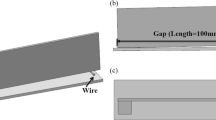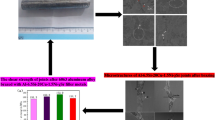Abstract
It has been mainly studied in this paper on brazing of Cu to Al using Al-Si filler metal. The optimized scanning rate of 2.5 mm/s is first obtained through simulating the temperature field of Cu-Al brazing process based on ANSYS software. Then the brazing of Cu-C11000 to Al-3003 using Al-Si-La-Sr filler is carried out by torch brazing technology. It is found that the brazing seam region is mainly consisted of α-Al solid solution and CuAl2 IMC. Further experimental results also show that the rare earth element La in filler metal can not only refine the grain, but also promote the dispersion of intermetallic compounds into the brazing seam, which significantly improves the brazing seam microstructure and mechanical properties of the joints.
Similar content being viewed by others
References
H. S. Shi, J. S. Park, Y. C. Jung, J. H. Ahn, Y. Yokoyama and A. Inoue, Similar and dissimilar friction welding of Zr-Cu-Al bulk glassy alloys, Journal of Alloys and Compounds, 483(1–2) (2009) 182–185.
M. NaKa and K. M. Hafez, Applying of ultrasonic waves on brazing of alumina to copper using Zn-Al filler alloy, Journal of Materials Science, 38 (2003) 3491–3494.
J. S. Seo and S. Y. Beck, Ultrasonic deposit junction characteristic evaluation of metal sheets Al/Al and Al/Cu, Korean Journal of Metals and Materials, 49(8) (2011) 642–648.
P. Xue, D. R. Ni, D. Wang, B. L. Xiao and Z. Y. Ma, Effect of friction stir welding parameters on the microstructure and mechanical properties of the dissimilar Al-Cu joints, Materials Science and Engineering A, 528 (2011) 4683–4689.
C. Genevois, M. Girard, B. Huneau, X. Sauvage and G. Racineux, Interfacial Reaction during Friction Stir Welding of Al and Cu, VOLUME, 42A (2011) 2290–2295.
W. B. Lee, K. S. Bang, S. B. Seung-Boo Jung, Effects of intermetallic compound on the electrical and mechanical properties of friction welded Cu/Al bimetallic joints during annealing, Journal of Alloys and Compounds, 390(1–2) (2005) 212–219.
T. A. Mai and A. C. Spowage, Characterisation of dissimilar joints in laser welding of steel-kovar, copper-steel and copper-aluminium, Materials Science and Engineering A, 374(1–2) (2004) 224–233.
K. Ono, K. Adachi and I. Miyamoto, Weldability of mild steel with oxide film in high power CO2 laser welding, Proceedings of the Society of Photo-optical Instrumentation Engineers, 4831 (2003) 411–415.
K. Nogi, Y. Sumi and Y. Aoki, Welding phenomena of aluminum-copper alloy in electron beam welding, Materials Science Forum, 331(3) (2000) 1763–1768.
F. Gao, H. Zhao, D. P. Sekulic, Y. Y. Qian and L. Walker, Solid state Si diffusion and joint formation involving aluminum brazing sheet, Materials Science and Engineering A, 337(1–2) (2002) 228–235.
K.F. Fang, Materials Engineering Manual: Non-ferrous Metal Materials Volume, Beijing Publishing Company, Beijing, China (2002).
D.B. Huang, Non-ferrous Metal Materials Manual, Chemical Industry Press, Beijing, China (2005).
Editorial Group, Light Metals Material Processing Manual, Metallurgical Industry Press, Beijing, China (1980).
G. W. Zhang, Y. F. Bao, Y. F. Jiang and H. Zhu, Microstructure and Mechanical properties of 6063 aluminum alloy brazed joints with Al-Si-Cu-Ni-RE filler metal, Journal of Materials Engineering and Performance, 20(8) (2011) 1451–1456.
C. Z. Xia, Y. J. Lia, U. A. Puchkovb, S. A. Gerasimovb and J. Wang, Microstructure and phase constitution near the interface of Cu/Al vacuum brazing using Al-Si filler metal, Vacuum, 82 (2008) 799–804.
K. Ken, S. Kenji, I. Kenji, M. Keiji, K. Hidenori, Evaluation of brazing properties using Al-Si-Mg-Bi brazing alloy-Development of brazing technique for Al-Cu dissimilar joint, Journal of Light Metal Welding and Construction, 40(9) (2002) 13–20.
Author information
Authors and Affiliations
Corresponding author
Additional information
Recommended by Associate Editor In-Ha Sung
Fei Yan received his Master’s Degree in Material Processing Engineering from Hefei University of Technology, China, in 2010. He is currently pursuing a Ph.D degree at the School of Materials Science and Engineering at HUST in Wuhan, China. His research is focused on laser materials processing.
Chun-ming Wang is an Associate Professor at the School of Materials Science and Engineering, Huazhong University of Science and Technology (HUST), China. His research interest is laser materials processing. He is the author of 20 published papers.
Rights and permissions
About this article
Cite this article
Yan, F., Xu, D., Wu, S.C. et al. Microstructure and phase constitution near the interface of Cu/3003 torch brazing using Al-Si-La-Sr filler. J Mech Sci Technol 26, 4089–4096 (2012). https://doi.org/10.1007/s12206-012-0884-7
Received:
Revised:
Accepted:
Published:
Issue Date:
DOI: https://doi.org/10.1007/s12206-012-0884-7




